School of Medicine Student Organizes Community Course To Bring Dermatological Education to Underserved Communities
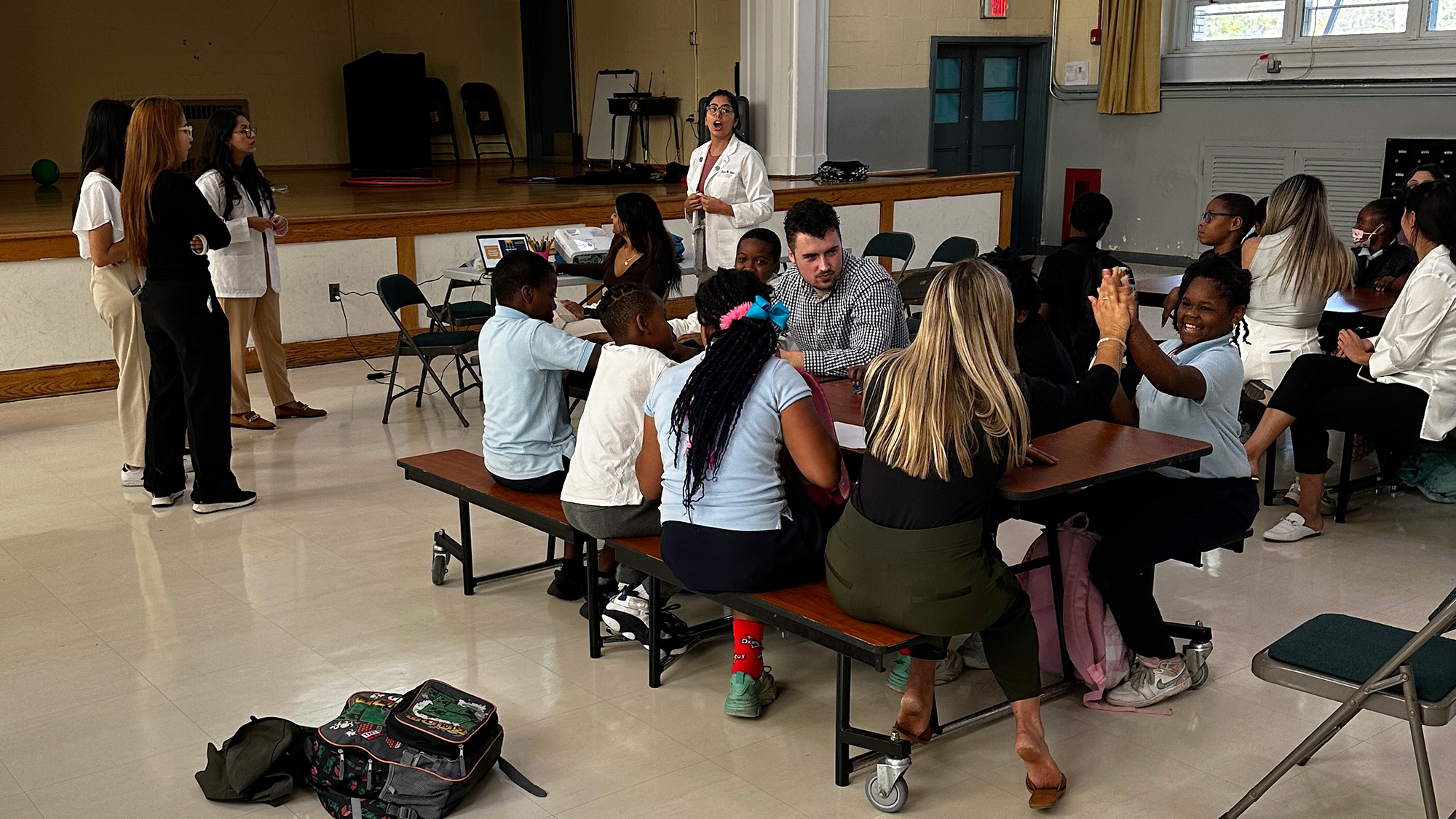
Posted in News Stories | Tagged community outreach, community-based learning, dermatology, health disparities, student experience, sun safety
(March 25, 2024) — When Umayr Shaikh (M’26) taught junior high school students about the systems of the body during a Georgetown course in community-based learning, he found that he wasn’t well equipped to teach about the system that interested the students the most: the integumentary system, or skin. After learning about a dermatology curriculum developed for school-age children by medical students, Shaikh excitedly started making plans to organize a new community-based learning course bringing dermatological education to underserved elementary school students.
“My inspiration for the course grew out of my experience in my own CBL course as a first-year medical student,” said Shaikh. “While teaching seventh and eighth graders at St. Thomas More Academy about different systems of the body, students had a lot of interest in learning more about their skin, and we just didn’t have the educational resources to cover that.”
All first-year medical students at Georgetown are required to take a community-based learning course, where they work in community on a range of topics from premature morbidity and mortality to healthy activities for seniors.
Finding Community Partners
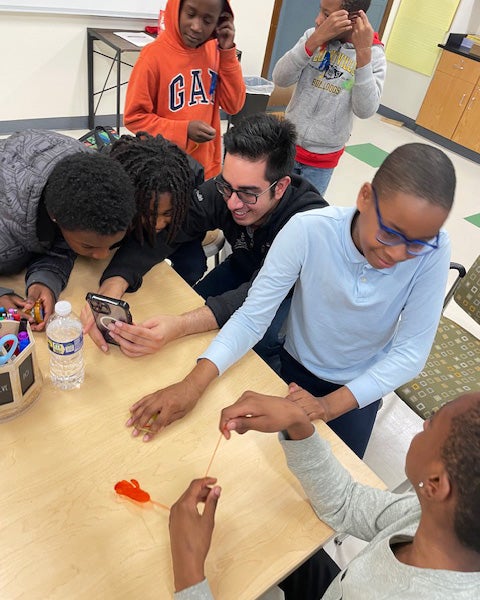
A few months after completing his own CBL course, Shaikh volunteered at a community health fair in May 2023 with a local organization, Learn2Derm.
“I volunteered to help Learn2Derm setup for the health fair and was just blown away by how many passionate people I met who were eager to share all they knew about dermatology,” said Shaikh.
“The Learn2Derm health fair is an essential conduit to reach underserved populations in DC, where individuals often face enduring skin conditions without access to specialized care and are less likely to be able to follow up with a specialty provider,” said Sarah Millan, MD, current MedStar Health dermatology resident and founder of Learn2Derm. “Through these events, we provide skin care products, facilitate connections with dermatologic support groups, and initiate vital discussions on effectively managing diverse skin conditions while dispelling prevalent misconceptions. We also teach about skin diseases and show pictures across all skin tones, as skin disease does not always look the same in all skin tones.”
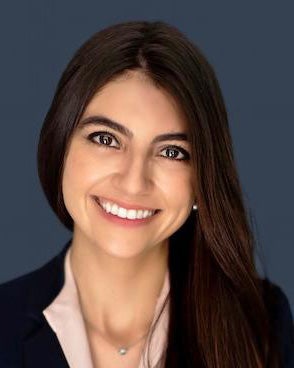
After speaking with other local medical students and residents involved with Learn2Derm, Shaikh realized the organization developed a youth curriculum approved by board-certified dermatologists and tailored to specific age groups.
“I connected the dots with the Learn2Derm curriculum and the kids from St. Thomas that we had a way to get information to the community through a CBL course,” said Shaikh. He reached out to the CBL course coordinator at Georgetown and proposed the new course. with Millan as the sponsoring faculty member.
Shaikh’s proposal for the new CBL course was quickly approved, and the first cohort of 12 first-year medical students and Shaikh met for the first time in August 2023. Over seven sessions this January, the medical students met with 25 to 30 fourth and fifth graders at Garfield Elementary.
Teaching in Community
First-year medical students led each lesson in the Learn2Derm. Before meeting with the elementary students, Millan and Umayr met with the 12 medical students to rehearse their presentations. Topics covered in the sessions included, but were not limited to, face washing, layers of the skin, acne, ultraviolet (UV) radiation exposure, and unveiling the truth behind social media filters. Each session also included an interactive activity.
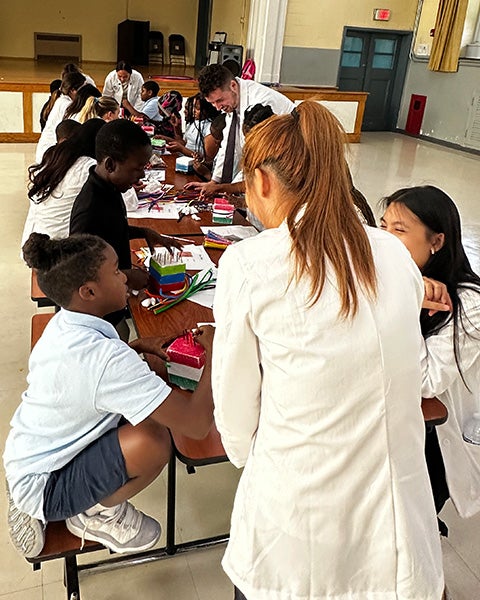
In an early session, medical students broke the common misconception that acne is caused by dirty skin and then went over proper face-washing technique, emphasizing that over scrubbing can actually worsen acne. The medical students also discussed the emotional toll acne can take on a person during their youth.
“It’s amazing to see the fourth and fifth graders becoming aware of their skin during the sessions,” said Shaikh. “I’ll look out into the audience and just see them staring at their own skin.”
In a session about layers of the skin, the Garfield Elementary students built a skin model using styrofoam blocks and art supplies based on information provided by the American Academy of Dermatology (AAD) Good Skin Knowledge program. Students attached white cotton balls to the bottom subcutaneous fat layer, pipe cleaners for blood vessels in the dermis layer, and matchsticks for hair follicles extending out of the top epidermis layer.
In a lesson focused on sun exposure, the elementary students created bracelets using UV beads that turn purple when exposed to the sun. The medical students discussed the importance of sun protection, including recommending wearing sunscreen every day.
“The UV beads were very popular,” said Shaikh.
Learn2Derm works to develop partnerships with pharmaceutical companies and dermatological support groups for supplies and educational resources like AAD and Impact Melanoma, which donated the UV beads.
Multiplying Effects
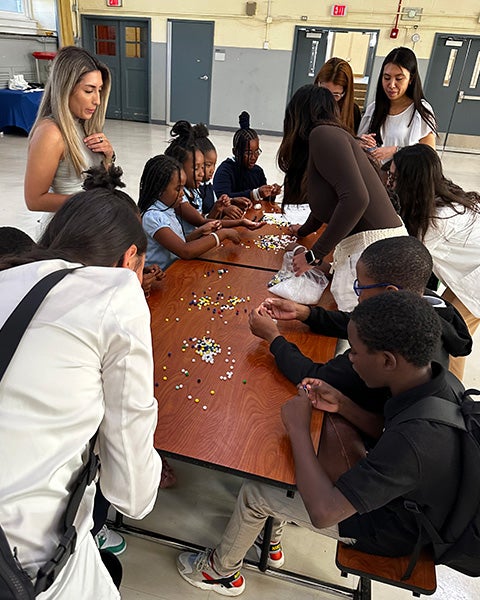
Shaikh is pleased with how the CBL course turned out and hopes to expand his and Learn2Derm’s efforts to bring dermatological education to underserved communities.
“This was a new course, new curriculum, and a new site (Garfield Elementary), so we weren’t sure how things would go,” said Shaikh. “But everything turned out incredibly well. It was amazing to see the growth in the students between sessions in expanding their knowledge.”
Shaikh hopes the Learn2Derm curriculum is used in an annual CBL offering and is working on partnering with HOYA Clinic to make dermatological education materials available to clinic patients.
“I’m working with some other medical students on transforming some of the Learn2Derm lessons plans into a pamphlet that could be helpful to our clinic patients,” said Shaikh. The hope is that the pamphlet, like the information conveyed in the CBL course, will be shared with family members and friends and have a multiplying effect in the community.
Shaikh expressed so much gratitude for Millan in creating the Learn2Derm program and for being such a wonderful mentor and friend.
“I just finished taking my Step 1 exams, and Sarah [Millan] texted me to see how things went,” said Shaikh. “It’s really amazing. I feel like I found a second family with Learn2Derm.”
Millan and Shaikh would also like to extend their gratitude to others who supported this work, including mentor Adam Friedman, MD, chair of the GW Dermatology Department; co-founder Deega Omar, MD, MPH; and event leaders Cleo Whiting and Peter Baek from George Washington University School of Medicine and Health Sciences (GW SMHS). They also wish to acknowledge the invaluable contributions of youth curriculum leaders Savanna Vidal and Nikkia Zarabian from GW SMHS.
Heather Wilpone-Welborn
GUMC Communications
Those interested can explore @Learn2Derm on social media to view snapshots of their previous events, showcasing the collaborative efforts of medical student volunteers from medical institutions across the DC area. You can also stay updated regarding an upcoming event on June 29, 2024, marking the fifth Learn2Derm event.
